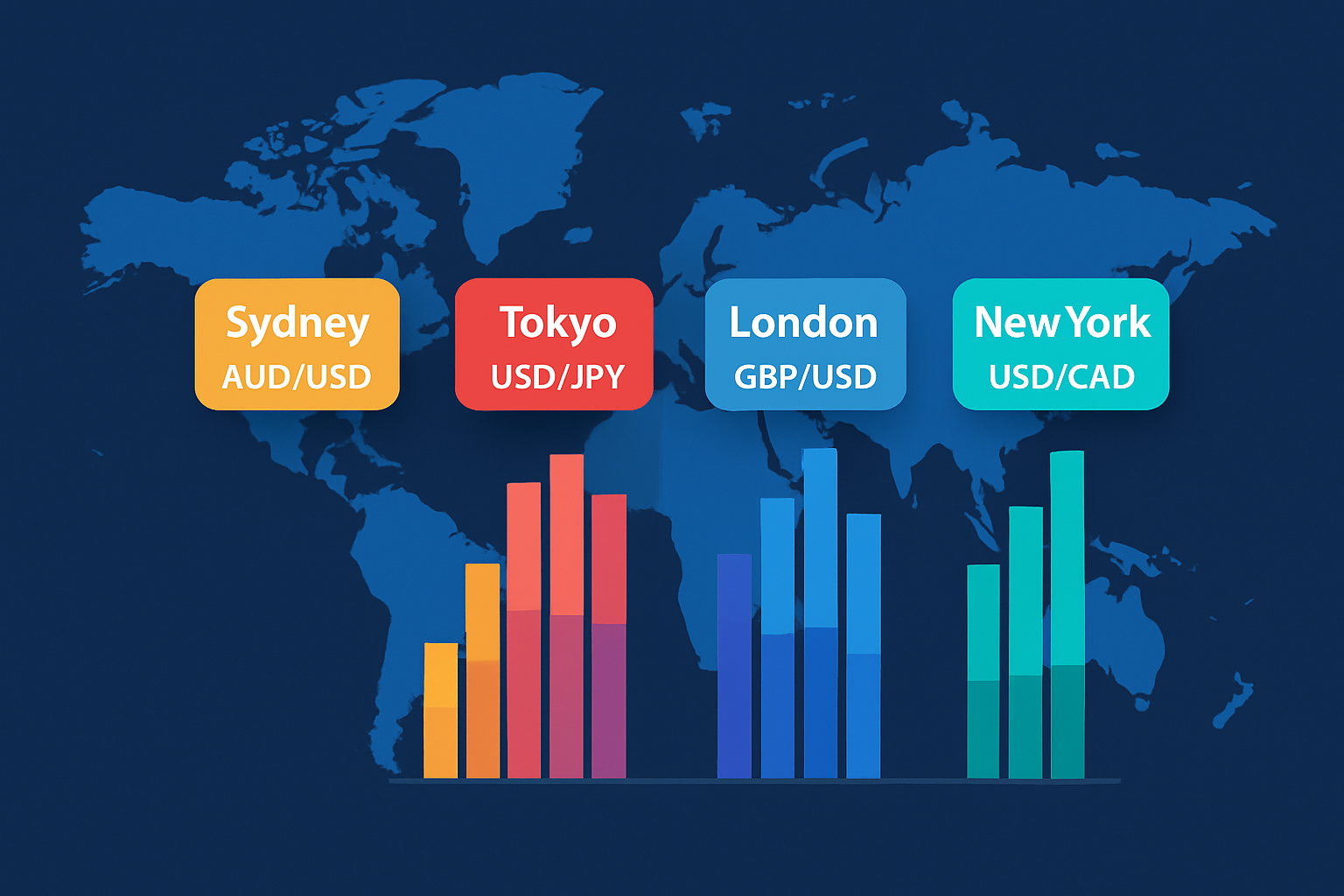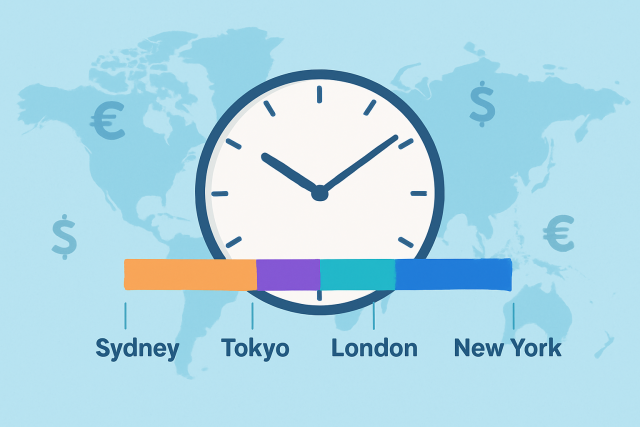
Trading Forex For Beginners To Get Started Smoothly
Discover how to trade forex for beginners with easy-to-understand concepts, step-by-step guides, and...

This guide breaks down forex time zones and trading sessions to help traders seize opportunities without losing sleep over risks.
The forex market stands tall as the biggest financial arena with daily trading volumes that regularly shoot past a staggering $6 trillion. For traders around the globe, understanding the tricky dance of forex time zones and trading sessions is key to unlocking its true potential. This guide takes a friendly stroll through how forex time zones operate and reveals how syncing with worldwide trading hours can ramp up liquidity, ease risks, and highlight the best opportunities available.
The forex market pretty much never sleeps from Monday through Friday since it’s totally decentralized—there’s no single exchange calling the shots. Because it stretches across multiple time zones, this patchwork quilt truly shapes how liquid and volatile things get.
Forex time zones tie into the different market hours set by major financial hubs scattered across the globe. These zones essentially dictate when various forex trading sessions kick off and wind down, shaping the ebb and flow of market liquidity and volatility.
The forex market is sliced into four main trading sessions linked to major financial hubs: Sydney, Tokyo, London and New York. Each session has its own distinct flavor shaped by local economic vibes and trader behaviors. The currencies that tend to steal the spotlight vary by region.
| Session Name | Local Time | UTC Time | Major Currency Pairs Active | Key Characteristics |
|---|---|---|---|---|
| Sydney | 10:00 PM - 7:00 AM | 9:00 PM - 6:00 AM | AUD/USD, NZD/USD, USD/JPY | Usually sees low to moderate volatility, quietly kicking off the trading week as the rest of the world gets ready to join in |
| Tokyo | 12:00 AM - 9:00 AM | 11:00 PM - 8:00 AM | USD/JPY, EUR/JPY, AUD/JPY | Trades at a moderate pace, with a clear spotlight on Asian currencies – it’s where the action subtly heats up |
| London | 8:00 AM - 5:00 PM | 7:00 AM - 4:00 PM | EUR/USD, GBP/USD, USD/CHF | This session packs the punch, boasting the highest liquidity and keeping the major FX pairs buzzing with activity |
| New York | 1:00 PM - 10:00 PM | 12:00 PM - 9:00 PM | USD/CAD, EUR/USD, GBP/USD | Often brings high volatility to the table, largely driven by the rollercoaster of US economic data |
The Sydney session kicks off the global forex trading day at 10 PM local time. It mainly shines the spotlight on Australian and New Zealand dollar pairs. You will often find it’s a bit calmer here, with lower volatility and trading volumes.
When the world’s markets are still waking up and grabbing their first coffee, the Tokyo trading session quietly kicks into gear. It might not always hog the headlines, but this session plays a important role in setting the tone for Asian and often global trading days. Traders here often find a unique rhythm, balancing steady moves with moments of surprise—kind of like a calm before the storm elsewhere. If you’ve ever wondered where those early market jitters come from, the Tokyo session usually has a few clues tucked away.
The Tokyo session follows with a bit of an overlap with Sydney’s hours. It usually sparks more activity in yen-related pairs like USD/JPY and EUR/JPY. Liquidity gets a nice boost but remains relatively moderate compared to the busier sessions that come later.
Ah, the London Session—the buzzing heart of the forex market where the action really heats up. It is the time when European banks, traders, and investors roll up their sleeves and dive into the fray, often setting the tone for the rest of the day. If you’ve ever wondered when the market wakes up with a bang, this session is often it, as liquidity flows in and opportunities pop up like daisies in spring.
You might say it’s a bit like the morning coffee of trading hours, essential, energizing, and, let’s be honest, occasionally a little unpredictable. Whether you’re a seasoned pro or just dipping your toes into the forex waters, the London Session’s mix of volatility and volume can offer a pretty lively playground—just remember to hold your horses and keep an eye on those economic releases that often crash the party unexpectedly.
The London session is frequently hailed as the busiest and most liquid stretch in the forex day, and for good reason. It overlaps with the tail end of the Tokyo session and the early buzz of the New York session, a perfect storm that often sparks sharp spikes in trading volume. Major pairs like EUR/USD and GBP/USD tend to put on quite the show with notable price swings during this window, pulling in a crowd of institutional traders who don’t want to miss a beat.
The New York session kicks off right around midday Eastern Time and often brings a noticeable burst of activity, especially when it comes to USD-based pairs like USD/CAD and EUR/USD. Volatility tends to pick up steam after major US economic announcements, making this session a playground for traders who thrive on fast-moving markets. It also overlaps with the London session in the afternoon, which gives liquidity a nice little boost and opens up more trading opportunities—especially during those first few hectic hours. Traders who lean on advanced platforms like TradingView or TrendSpider can easily keep tabs on these busy stretches, thanks to real-time data and technical tools tailored for this particular window.
Forex session overlaps occur when two trading sessions overlap, creating a buzz of increased market liquidity and volatility. The London-New York overlap is usually where all the action happens, offering prime conditions for traders eager to ride the wave of price momentum.

Illustration of global forex trading sessions with highlighted time zones and overlap periods for better understanding of market hours.
Optimizing your trading by syncing up with forex time zones is really about choosing sessions that click both with your personal trading style and your local clock. When you zero in on those juicy periods of high liquidity and volatility, you often find your entry points get sharper and slippage takes a backseat.
Nail down your local time zone and understand how it compares to the main forex trading hubs.
Convert the opening and closing times of the big four sessions into your local time. This simple step will save you from scheduling headaches later.
Focus on currency pairs that are active during your preferred trading sessions because that’s where you’ll find better volatility and more action.
Try to trade during the overlaps of sessions. These periods are like the market’s happy hour, offering higher liquidity and tighter spreads.
Manage your risk by adjusting your trade sizes based on how volatile the session appears. Also, it’s best to avoid trading when the market is sluggish and volume is low.
Navigating the ups and downs of the market across various time zones can feel a bit like juggling flaming torches—tricky, but totally doable once you get the hang of it. Whether you’re a night owl catching the Asian markets or an early bird diving into the New York session, having strategies that fit the clock you are working against makes all the difference. Let’s break down how tailoring your approach to the rhythm of different time zones can help you trade smarter, not harder.
Various trading styles naturally gel better with certain forex sessions than others. Scalpers often jump at the chance to ride the waves of high volatility during overlapping hours when everything gets hectic. Day traders tend to focus on catching the more active sessions and try to snatch moves while the market's buzzing. Meanwhile, swing traders usually prefer to hang back during slower periods that let you set up trades with more patience and less nail-biting.
Trading across forex time zones definitely comes with perks but it also throws curveballs your way—like getting mixed up over session timings when daylight saving time (DST) shakes things up. Many traders, myself included at times, find it tricky to rejig their schedules. This can mean missing trades or getting stuck trading during sleepy periods of low liquidity. Add the hassle of juggling inconsistent trading hours with your local work and sleep routines and it’s no surprise focus and discipline can slip.
"Mastering forex time zones isn’t just a nice-to-have; it’s absolutely essential to dodge costly slip-ups and squeeze the best out of your trade execution. Getting a real feel for when the markets are truly buzzing lets traders move with precision instead of flying blind on guesswork." — Senior Forex Analyst
There are quite a few handy tools that make juggling forex time zones less like rocket science—think session time converters, economic calendars and alert systems that chirp when sessions kick off or important news drops. Platforms like TradingView go the extra mile by mixing sharp charting with session highlights. Mobile alerts keep traders in the loop even if they’ve stepped away from their screens for a breather.
Knowing the different forex time zones gives traders a handy edge and helps them sync up with the market's 24-hour hustle more smoothly. Once you get familiar with the four main trading sessions and how their hours overlap, you can tap into better liquidity, keep risk in check and boost your chances of turning a profit. Pairing that session know-how with robust trading tools like Binance for firing off trades or TradingView for market analysis makes your decision-making sharper.
Are you tired of juggling multiple tools for your trading needs? TradingView is the all-in-one platform that streamlines your analysis and decision-making.
With its powerful charting capabilities, real-time data, and vibrant community, TradingView empowers traders like you to stay ahead of the market. Join thousands who trust TradingView for their trading success.
Are you ready to elevate your trading game? Binance, the leading cryptocurrency exchange, offers a seamless platform for traders of all levels. With its user-friendly interface and powerful tools, you can navigate the dynamic world of digital assets with confidence.
16 articles published
Driven by a passion for democratizing financial markets, Vivienne creates educational content on forex trading and currency market fundamentals for beginners.
Read Posts
Discover how to trade forex for beginners with easy-to-understand concepts, step-by-step guides, and...

Discover how forex market opening hours shape trading strategies worldwide. Learn the key sessions,...

Leverage in forex lets traders control bigger positions with less capital. Learn how it works, its r...

Timing is critical in Forex trading. Learn how to trade during peak market sessions and overlaps to...
